- News
- Reviews
- Bikes
- Accessories
- Accessories - misc
- Computer mounts
- Bags
- Bar ends
- Bike bags & cases
- Bottle cages
- Bottles
- Cameras
- Car racks
- Child seats
- Computers
- Glasses
- GPS units
- Helmets
- Lights - front
- Lights - rear
- Lights - sets
- Locks
- Mirrors
- Mudguards
- Racks
- Pumps & CO2 inflators
- Puncture kits
- Reflectives
- Smart watches
- Stands and racks
- Trailers
- Clothing
- Components
- Bar tape & grips
- Bottom brackets
- Brake & gear cables
- Brake & STI levers
- Brake pads & spares
- Brakes
- Cassettes & freewheels
- Chains
- Chainsets & chainrings
- Derailleurs - front
- Derailleurs - rear
- Forks
- Gear levers & shifters
- Groupsets
- Handlebars & extensions
- Headsets
- Hubs
- Inner tubes
- Pedals
- Quick releases & skewers
- Saddles
- Seatposts
- Stems
- Wheels
- Tyres
- Health, fitness and nutrition
- Tools and workshop
- Miscellaneous
- Cross country mountain bikes
- Tubeless valves
- Buyers Guides
- Features
- Forum
- Recommends
- Podcast
review
£6,400.00
VERDICT:
Fast, stiff and responsive aero road bike provides electrifying ride that speed merchants will love
Weight:
7,380g
Contact:
www.ridley-bikes.com
At road.cc every product is thoroughly tested for as long as it takes to get a proper insight into how well it works. Our reviewers are experienced cyclists that we trust to be objective. While we strive to ensure that opinions expressed are backed up by facts, reviews are by their nature an informed opinion, not a definitive verdict. We don't intentionally try to break anything (except locks) but we do try to look for weak points in any design. The overall score is not just an average of the other scores: it reflects both a product's function and value – with value determined by how a product compares with items of similar spec, quality, and price.
What the road.cc scores meanGood scores are more common than bad, because fortunately good products are more common than bad.
- Exceptional
- Excellent
- Very Good
- Good
- Quite good
- Average
- Not so good
- Poor
- Bad
- Appalling
Ridley's Noah Fast is packed with cutting-edge aerodynamic technology, and it provides an electrifying ride with a scintillating turn of speed and sharp handling that racers and speed merchants alike will adore. And it's not so uncomfortable that you couldn't live with it on a daily basis... provided you could afford it that is.
For a long time now bike manufacturers and cyclists have been concerned two key parameters when designing bikes: weight and stiffness. We've seen an incredible pace of technological development in just the past decade that has seen the weight of frames tumble while stiffness has ramped up. With bikes comfortably below the UCI's 6.8kg weight limit and more stiffness than is necessary, the engineers and designers have shifted their attention to aerodynamics.

Wind resistance is the biggest force a cyclist has to overcome on the road. At between 70% to 90% of the overall resistance, it's a bigger factor than rolling resistance and drivetrain friction, which together contribute a small proportion of drag. The faster you ride the more power is required to punch a hole through the air. Reduce the drag and you can ride faster, or produce less power at any given speed. While the cyclist clearly produces the most drag, a bicycle is still responsible for around 20%. It's enough that manufacturers have turned their attention to producing aerodynamic road bikes. The aero road bike was born.
Belgium brand Ridley were one of the early adopters, first releasing the Noah aero road bike in 2006. It's advanced in recent years, undergoing a redesign in 2011, which introduced some new features designed to make it even faster. They currently produce two versions, one with regular caliper brakes, and the one we have here with the newest integrated brakes. It's available in various builds, I've been testing the £6,400 Dura-Ace build with Ridley's in-house 4ZA supplying most of the finishing kit, including the carbon clincher wheels.
Ride: Fast, lively and engaging
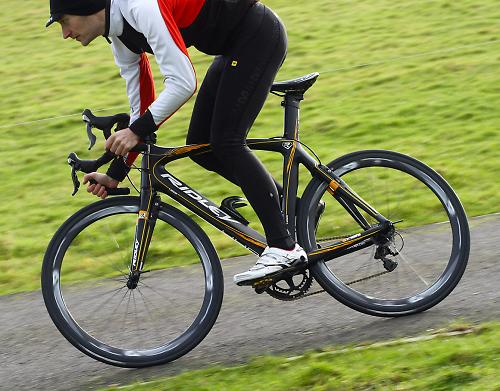
There's a lot of tech features on the Noah Fast, but I'll head up this review first with talking about how it rides, because that's the really important part of this review. Fortunately the Noah doesn't disappoint and lives up to its name. The performance is startling, with an incredible turn of speed, instantaneous acceleration and sharply focused handling.
I've ridden some overwhelmingly fast bikes in my time, but the Ridley offers speed on another level. Any scepticism that an aero bike wouldn't live up to all the wind tunnel hype and claims were quickly dispelled even after the first test ride, a couple of hours around my regular training roads.
After some time getting a comfortable fit and becoming acquainted with the Noah, I was able to start exploiting the finely engineered frame and discovered that it's a bike that excels in all situations. Not only is it rapid, but it also displays a sure-footedness and stability that results a bike with easily exploitable speed. There's little drama or fuss when taking the Noah up to speed, and that's perhaps its most likeable characteristic: how easy it is to ride fast.

It maintains that speed easily too, whether you're cruising along on the hoods or hammering in the drops chasing a fast wheel or trying to topple a PB. It surges ahead with ease, pedal inputs resulting in instant forward propulsion with negligible delay. The frame is stiff in all the right places to transfer power with startling efficiency.
The Noah really shines in the handling stakes too. The frame displays high levels of stiffness when you push hard on the pedals, so it thrusts forward with conviction. But the high level of stiffness also manifests itself through the corners and on the descents, where the Noah proves to be fantastically quick. Let the brakes go on a fast sweep descent and the Noah will take off, piling on speed rapidly. Lean into the corners and it tracks smartly and without fuss, instilling a lot of confidence. This allows you to ride fast without drama.
If there's a negative with the Noah, then it is ride comfort. It's clearly not a bike built for comfort, Ridley have the Helium SL for those seeking a smoother ride better suited to everyday and all-day riding. Let's be clear here, this is a bike designed for going fast, and as with most machines built for speed (and I'm thinking sports cars as an example here) comfort doesn't come high up the list of priorities, if a factor at all.
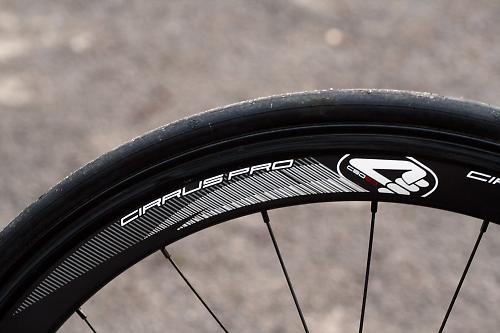
So at first it was no surprise the ride was hard and just a little harsh on the rougher roads. I suspected the 4ZA carbon clincher wheels might be partly to blame, and my hunch proved to be correct when I replaced them with a pair of Shimano RS80 wheels. The ride was transformed, revealing the frame itself to boast an impressive level of comfort. Enough that riding it for long periods produced no discomfort. While it's clearly not going to be your first choice for a comfort/endurance bike, it's not quite as bad as you might have thought.
The Noah Fast frame is packed with aerodynamics features that together, claims Ridley, provides a 20 watt saving over their Helium SL when riding at 40kph. For all the claims that come with aero products, actually testing them in the real-world is very tricky. Without our own wind tunnel we're unable to quantify any such performance gains, so we can only offer seat of the pants opinions. An attempt at back-to-back testing with a Powertap and using a regular road bike (Cannondale Supersix Evo) on the same roads produced results of variable quality – there's just too many uncontrollable variables that we're unable to remove.
So while unable to collect any useful data, I did conclude from my my testing that there are performance gains. Gains however that are marginal at best. Still, if you want to go faster, the Noah doesn't disappoint.
If speed and handling are key priorities for you, then the Noah scores highly in this areas. The only downside to such a bike is that it eggs you on to ride fast everywhere all of the time, which can start to be a drain on your fitness if you willingly oblige every time you go for a ride.

I rode a size medium, which a 56cm effective top tube. It has a 99cm wheelbase and parallel 73 degree head and seat angles. The only surprise in the geometry is the 17.5cm head tube, which could be considered tall for a such a race bike. A 15 to 16cm would be a more common sight on a bike regularly piloted by professional riders, and it's no surprise many of the Lotto-Belisol riders opt for negative rise stems. I found the height of the bars satisfactory during the test.
Frame and fork: Aero, aero and more aero
The frame is made from high modulus carbon fibre and features large aero shaped tube profiles and an integrated seatmast. Beauty is in the eye of the beholder and I don't personally feel the paint finish on this model does it many favours, but there's no denying it has a striking presence. I've seen a lot worse. You're guaranteed to turn heads whether at the traffic lights or on the start line of a road race.

The Noah Fast packs three key aero features, besides the aero shaped tubes. These are F-Splitfork, F-Surface and F-Brake. The F-Splitfork technology is very interesting. First developed by Oval Concepts a few years ago and licensed by Ridley, these vertical slots in teh fork and seat stays reduce air interacting with the spokes and wheels by channelling it away through the slots. With the fork they claim it reduces drag by up to 7%.
F-Surface is a 5mm-wide raised strip, applied to the leading edge of the head tube, seat tube and seat mast, that is designed to delay flow separation and keep the air attached for as long as possible. Their job is to trip the passing air into turbulence, so the separation point is shifted further along the tube profile. The longer the air is attached to the tube, the lower the drag, when air separates you get a small area of low pressure behind the tube, which produces drag. Their wind tunnel tests boast a 4.02% decrease in drag at 50kph. Out in the real world it's very hard to detect any tangible benefit - although equally that doesn't mean there isn't some marginal benefit there.
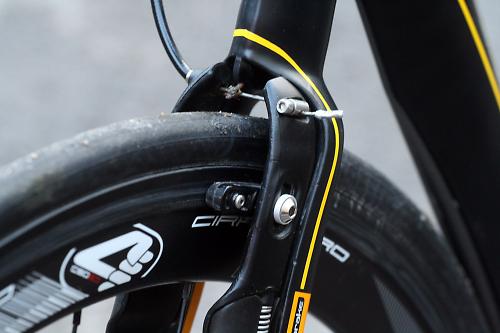
We're seeing integrated brakes a lot more these days, and the reason is because removing the brake caliper is believed to be one method of reducing drag. Ridley's F-Brakes are neatly incorporated into the carbon fibre structure, and rely on the flex in the carbon to deliver the necessary range of movement. The front brake is at the back of the fork and the rear brake is in the usual position on the seat stays. They can be easily adjusted, with small springs to adjust the centering.
Their performance was impressive. They offer vastly more power than regular caliper brakes, and this means your braking distances are much reduced. At the lever less force is required than calipers, with one-finger braking possible in all situations. This extra power meant I could leave my braking later, confident in their stopping ability, with the upshot that you can carry more speed through corners and down descents. I'd happily have these brakes on all my bikes, they make calipers look and feel very old fashioned by comparison.
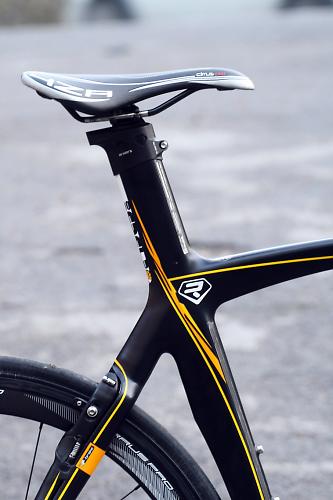
Elsewhere, the frame features a tapered steerer tube (1 1/8- to 1 1/2-inch) and it's been designed with stiffness in mind as much as aerodynamics. The integrated seatmast has a single bolt clamp on the top which offers a large amount of fore-aft adjustment. The clamp itself offers a small degree of height adjustment, but as with all seatmasts, you want to measure five times and cut once.
Cables in the carbon frame are all routed internally. The rear brake passes through the top tube, and the gear cables run along the downtube. A plastic cable guide grommet on the belly of the bottom routes the cables to each dérailleur, as well as making it easier to thread the cables inside the frame.
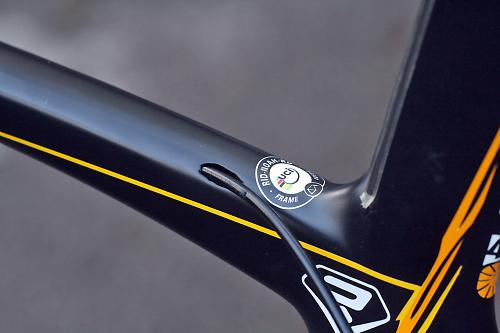
But as I found out when I had to fit new gear cables to the test bike when it arrived, it's far from an easy process. It's doable, just extremely fiddly. Definitely one for the bike shop or advanced home mechanic. The internal cable routing is designed to work with both mechanical and electronic groupsets, with the fitting of specific stops at the entry points in the frame.
Build kit: Dependable Dura-Ace and 4ZA in-house kit

You can buy the frame and fork alone for £3,899, or choose from a number of different build options. Our test bike arrived with a collection of Shimano Dura-Ace shifters and brake levers and a Rotor 3D chainset with round rings, and costs £6,400. That's a lot of money, but then this frame is packed with cutting-edge aero technology, some of which no other manufacturers are doing.
I had few complaints generally with the 4ZA equipment, Ridley's in-house component label. The Cirrus Pro AC58 wheels are an all-carbon clincher 58mm rim with a V-shaped section. Ridely, like Reynolds, go a V-shaped profile rather than the fatter bulbous profile now found on aero rims from the likes of Zipp and Bontrager. The hubs have sealed cartridge bearings and there's 20 double butted spokes in the front wheel and 24 in the rear wheel.

They're uncompromisingly stiff and noisy, rattling and crashing over rough roads. In a straight line with little wind, they spin up to speed well, and throwing them around in the corners is a delight. Acceleration in a straight line is good, but get them in a cross-wind and they're a handful. And at 1.7kg for the pair they're a bit portly, which robs the Noah of pace on the climbs. The Cirrus Pro 23mm tyres proved to be fast-rolling and grippy in the dry and wet.
The one-piece 4ZA stem and bar adds to the aero credentials, but its single biggest failing is the restriction in adjustment. The stem was too short for my liking but because of the design I wasn't able to change it.
The saddle was a comfortable shape, similar to that of a Prologo Scratch, which is no bad thing as it's one of my favourites.
When it comes to aero road bikes in general if there's a downside It's when you get them on the scales. Not so with the Ridley, as the road.cc scales revealed it to be 7.38 kg (16.27 lbs). Okay so it's heavier than an equivalent Helium SL would be with this sort of build, but it's far from heavy. Unless you're an out-and-out weight weenie climber, it's light enough that climbs are scaled with no shortage of pace. Claimed weight for the frame is 1,200g.
Verdict
Marginal aero benefits they may be, but the Noah Fast's ability to deliver high speed performance is stunning, as is its handling and ride comfort, once you change the wheels. Aero bikes are developing at a rapid rate, the Noah proves there is mileage in bikes designed to reduce drag. And the fact they've produced an aero bike with decent weight, good ride manners and handling is is a tribute to the Ridley design team. Aero bikes aren't for everyone, but if speed is your thing, the Noah Fast should impress.
road.cc test report
Make and model: Ridley Noah Fast
Size tested: 56cm
About the bike
State the frame and fork material and method of construction. List the components used to build up the bike.
The first bike with a 'real' integrated brake, our F-Brake. The Noah FB incorporates all of our FAST-Concept technologies. These combined technologies offer up to 2.8km/h advantage in the sprint, and up to 20 watts less power input needed to average a 40km/h breakaway. The Noah FB is the ultimate frame in the Word Tour peloton, no compromise, just pure speed.
Tell us what the bike is for, and who it's aimed at. What do the manufacturers say about it? How does that compare to your own feelings about the bike?
F-Brake reduces turbulence and drag by 4.3 %
Extended F-Splitfork reduces drag by 8.2% by drawing turbulent air away from spokes.
F-Surface paint technology reduces drag by 4.1% by increasing laminar flow.
Full carbon tapered 1-1/8 1-1/2 head tube with angular contact bearings.
Internally routed cabling to minimize airflow disturbance.
Oversized press fit BB30 bottom bracket and aero down tube.
Compatible with electronic and mechanical shifting
Frame and fork
Overall rating for frame and fork
8/10
Tell us about the build quality and finish of the frame and fork?
Excellent build quality
Tell us about the materials used in the frame and fork?
They use 30, 40 and 30-ton high modulus carbon fibre in key places to give it plenty of stiffness and reasonable ride comfort
Tell us about the geometry of the frame and fork?
Geometry is 73.5 degree head and seat angle which provides a good balance of stability and speed
How was the bike in terms of height and reach? How did it compare to other bikes of the same stated size?
The head tube is a bit tall for a race bike, and the one-piece stem/handlebar meant I could fit a longer stem
Riding the bike
Was the bike comfortable to ride? Tell us how you felt about the ride quality.
Surprisingly, yes it was reasonably comfortable, once I replaced the stiff carbon wheels
Did the bike feel stiff in the right places? Did any part of the bike feel too stiff or too flexible?
It sprints well and shows the stiffness through fast corners where it tracks brilliantly
How did the bike transfer power? Did it feel efficient?
Yes, very much so
Was there any toe-clip overlap with the front wheel? If so, was it a problem?
No
How would you describe the steering? Was it lively, neutral or unresponsive? Stable
Tell us some more about the handling. How did the bike feel overall? Did it do particular things well or badly?
The Noah's good handling was most revealed in fast descents, where it is blisteringly fast and tracks cleanly
Which components had the most effect (good or bad) on the bike's comfort? would you recommend any changes?
The wheels had a negative impact on the comfort, but did contribute to the sharp handling. They're very stiff
Which components had the most effect (good or bad) on the bike's stiffness? would you recommend any changes?
The wheels, I changed them for more comfortable wheels and that improved the comfort with little negative impact on the handling
Rate the bike for efficiency of power transfer:
8/10
Rate the bike for acceleration:
8/10
Rate the bike for sprinting:
8/10
Rate the bike for high speed stability:
9/10
Rate the bike for cruising speed stability:
8/10
Rate the bike for low speed stability:
8/10
Rate the bike for flat cornering:
8/10
Rate the bike for cornering on descents:
9/10
Rate the bike for climbing:
7/10
The drivetrain
Rate the drivetrain for performance:
8/10
Rate the drivetrain for durability:
8/10
Rate the drivetrain for weight:
8/10
Rate the drivetrain for value:
7/10
Wheels and tyres
Rate the wheels and tyres for performance:
7/10
The wheels were heavy and not very aero, and very very stiff
Rate the wheels and tyres for durability:
7/10
Rate the wheels and tyres for weight:
7/10
The wheels are heavy at 1.7kg
Rate the wheels and tyres for comfort:
6/10
The wheels were very stiff and noisy
Controls
Rate the controls for performance:
7/10
I didn't get on with the integrated bar and stem, it limits stem length
Rate the controls for durability:
7/10
Rate the controls for weight:
7/10
Rate the controls for comfort:
8/10
The saddle was very comfortable
Tell us some more about the controls. Any particularly good or bad components? How would the controls work for larger or smaller riders?
I'd change the handlebar and stem straight away if it was my bike. The saddle was very comfortable.
Your summary
Did you enjoy riding the bike? Yes
Would you consider buying the bike? Possibly
Would you recommend the bike to a friend? Yes
Rate the bike overall for performance:
8/10
Rate the bike overall for value:
7/10
Anything further to say about the bike in conclusion?
I really liked riding the Noah Fast, it's impressively fast, but I'd like to build one up with different components, as it was held back by the wheels and handlebars. Undeniably fast though. So I'd probably opt for the frameset option
About the tester
Age: 31 Height: 180 Weight: 67
I usually ride: My best bike is:
I've been riding for: 10-20 years I ride: Every day I would class myself as: Expert
I regularly do the following types of riding: road racing, time trialling, cyclo cross, commuting, touring, mtb,
David worked on the road.cc tech team from 2012-2020. Previously he was editor of Bikemagic.com and before that staff writer at RCUK. He's a seasoned cyclist of all disciplines, from road to mountain biking, touring to cyclo-cross, he only wishes he had time to ride them all. He's mildly competitive, though he'll never admit it, and is a frequent road racer but is too lazy to do really well. He currently resides in the Cotswolds, and you can now find him over on his own YouTube channel David Arthur - Just Ride Bikes.
Latest Comments
- ubercurmudgeon 6 hours 10 min ago
I had three different cyclocross bikes before the marketing departments at various bicycle companies came up with the "gravel" category. All of...
- Sredlums 6 hours 55 min ago
Maybe the UK could try to reach some sort of agreement with the EU over things like international trade and such.
- David9694 7 hours 24 min ago
Cumbria County Council was a 1974 creation, merging the of old County Borough of Carlisle, and counties of Cumberland, and Westmorland - in which...
- Backladder 7 hours 36 min ago
If BC want to insist on barriers then they should have their own stock loaded on a truck that they can rent out to organisers at reasonable cost,...
- Miller 8 hours 6 min ago
Well, there's lifetime bans and there's lifetime bans. Banning an 88 year old don't impress me much.
- Gkam84 11 hours 11 min ago
I think that is why blind eyes have been turned in the UK, internationally aswell, with things like the Redhook crits, there were many licensed...
- mdavidford 12 hours 20 min ago
Ahem - other esporters(?) might be rather surprised to hear that the UCI has taken over their events - I think that would be the Cycling Esports...
- Bungle_52 12 hours 29 min ago
I wonder how he got to the game?
- OldRidgeback 12 hours 32 min ago
You'd need some good wet weather gear for that ride too.
- OnYerBike 14 hours 56 min ago
It seems to me that the most likely explanation is that whoever provided that quote fails to grasp the difference between a "public right of way"...

































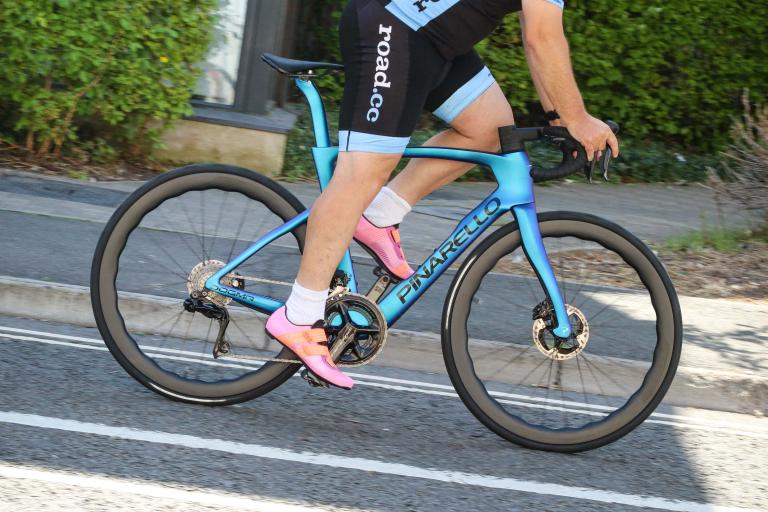
Add new comment
5 comments
It means it's stiff.
Quite.
"It surges ahead with ease, pedal inputs resulting in instant forward propulsion with negligible delay."
What does that actually mean? I know about turbo lag and understand the physics of that, but in what way can you detect any form of delay with a chain on a road bike? #justcuriouslike
"""build with Ridley's in-house 4ZA supplying most of the finishing kit, including the carbon clincher wheels""
OEM far eastern kit
Those one piece bar and stem jobbies are a bit of a nonsense aren't they. Considering all the variables you gain from by choosing the right parts in standard 2 parts set up - stem rise and length, bar width, drop shape, bar rotation - you'd be damn lucky to find an all in one solution that does everything right for you off the peg.